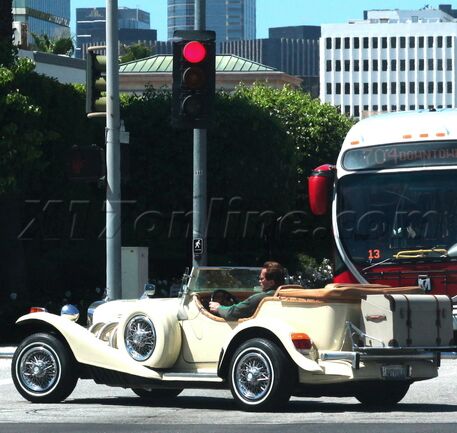California Governor Signs, Vetoes Red Light Camera Bills
California Governor Arnold Schwarzenegger (R) last week approved one bill and vetoed another, ensuring that the state government would maximize its share of red light camera revenue. On Wednesday, Schwarzenegger blocked legislation that would have slashed the fine for rolling right turn on red from $500 to $250 ( view bill). The potential loss of income from the change raised opposition outside the legislature.
The California League of Cities referred to the bill as a “de facto prohibition” on red light cameras because turning tickets account for up to 90 percent of the tickets issued in many jurisdictions. The state collects about $175 from each turning ticket, an amount that would have been cut in half had the bill been signed. The resulting reduction would cost the cash-strapped state government millions every year.
“I am returning Assembly Bill 909 without my signature,” Schwarzenegger wrote in his veto message. “A driver running a red-light, whether they are traveling straight, or turning right, makes a very dangerous traffic movement that endangers the nearby motoring public, bicyclists, and pedestrians. Modifying existing law to make red-light violations from a right turn less egregious sends the wrong message to the public that California is tolerant of these types of offenses. It is our responsibility to protect the motoring public and not increase the risk of traffic collisions. Therefore, I am unable to sign this bill.”
Because of the slow speeds involved, right-turn on red collisions are extremely rare. According to US Department of Transportation statistics, one could drive over a billion miles before being involved in such a crash. On Thursday, Schwarzenegger signed a separate bill into law whose primary purpose was to ensure the state would keep its $175 share of all photo enforcement fines — including those from right turns.
A number of jurisdictions had turned to creating “ administrative tickets” for red light camera fines and regular speeding tickets as a means of cutting the state and county out of the process. By citing motorists under municipal ordinances instead of under the state vehicle code, cities reduced the cost of a ticket from $500 each to $150 for the first offense, $300 for a second and $500 for a third. Instead of splitting the revenue with the state and county, however, the city kept all of it. Senate Bill 949 cancels this practice by explicitly denying localities authority to issue such tickets for offenses covered by the state vehicle code.
“This section does not authorize a local authority to enact or enforce an ordinance or resolution that establishes a violation if a violation for the same or similar conduct is provided in this code, nor does it authorize a local authority to enact or enforce an ordinance or resolution that assesses a fine, penalty, assessment, or fee for a violation if a fine, penalty, assessment, or fee for a violation involving the same or similar conduct is provided in this code,” the new law states.
The law takes effect on July 1, 2011. Because the administrative tickets did not report citations to the Department of Motor Vehicles, the citations did not carry license points. This irked companies like AAA, which makes money from raising insurance rates on recipients of license points, and companies that sponsor traffic schools, because motorists only take the school to keep points from going on their driving record.
[Courtesy: Thenewspaper.com]
More by The Newspaper
Latest Car Reviews
Read moreLatest Product Reviews
Read moreRecent Comments
- Joe65688619 Under Ghosn they went through the same short-term bottom-line thinking that GM did in the 80s/90s, and they have not recovered say, to their heyday in the 50s and 60s in terms of market share and innovation. Poor design decisions (a CVT in their front-wheel drive "4-Door Sports Car", model overlap in a poorly performing segment (they never needed the Altima AND the Maxima...what they needed was one vehicle with different drivetrain, including hybrid, to compete with the Accord/Camry, and decontenting their vehicles: My 2012 QX56 (I know, not a Nissan, but the same holds for the Armada) had power rear windows in the cargo area that could vent, a glass hatch on the back door that could be opened separate from the whole liftgate (in such a tall vehicle, kinda essential if you have it in a garage and want to load the trunk without having to open the garage door to make room for the lift gate), a nice driver's side folding armrest, and a few other quality-of-life details absent from my 2018 QX80. In a competitive market this attention to detai is can be the differentiator that sell cars. Now they are caught in the middle of the market, competing more with Hyundai and Kia and selling discounted vehicles near the same price points, but losing money on them. They invested also invested a lot in niche platforms. The Leaf was one of the first full EVs, but never really evolved. They misjudged the market - luxury EVs are selling, small budget models not so much. Variable compression engines offering little in terms of real-world power or tech, let a lot of complexity that is leading to higher failure rates. Aside from the Z and GT-R (low volume models), not much forced induction (whether your a fan or not, look at what Honda did with the CR-V and Acura RDX - same chassis, slap a turbo on it, make it nicer inside, and now you can sell it as a semi-premium brand with higher markup). That said, I do believe they retain the technical and engineering capability to do far better. About time management realized they need to make smarter investments and understand their markets better.
- Kwik_Shift_Pro4X Off-road fluff on vehicles that should not be off road needs to die.
- Kwik_Shift_Pro4X Saw this posted on social media; “Just bought a 2023 Tundra with the 14" screen. Let my son borrow it for the afternoon, he connected his phone to listen to his iTunes.The next day my insurance company raised my rates and added my son to my policy. The email said that a private company showed that my son drove the vehicle. He already had his own vehicle that he was insuring.My insurance company demanded he give all his insurance info and some private info for proof. He declined for privacy reasons and my insurance cancelled my policy.These new vehicles with their tech are on condition that we give up our privacy to enter their world. It's not worth it people.”
- TheEndlessEnigma Poor planning here, dropping a Vinfast dealer in Pensacola FL is just not going to work. I love Pensacola and that part of the Gulf Coast, but that area is by no means an EV adoption demographic.
- Keith Most of the stanced VAGS with roof racks are nuisance drivers in my area. Very likely this one's been driven hard. And that silly roof rack is extra $'s, likely at full retail lol. Reminds me of the guys back in the late 20th century would put in their ads that the installed aftermarket stereo would be a negotiated extra. Were they going to go find and reinstall that old Delco if you didn't want the Kraco/Jenson set up they hacked in?


































Comments
Join the conversation
Try to obey the law and take a right turn on red. You're supposed to stop at the white line some insane distance back from the intersection where you can't see the street you're entering. Then you're supposed to stop again where you can see, and then accelerate into the flow of traffic. Normal drivers instead roll across the stupid paint, stop and look for traffic near the cross street, and if there is an opening, accelerate onto the cross street. That normal safe driver action generates the red light revenue.
Stop at the white line and then pull forward slowly to see if it is safe. So they can get you for stopping properly and then trying to make your turn only to find it is not safe afterall? GRIN!